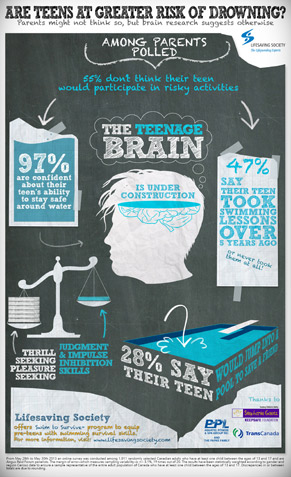GROWING BODY OF RESEARCH EXPLAINS WHY TEENS MAY BE AT INCREASED RISK OF DROWNING
Based on New Poll Findings Lifesaving Society Cautions Parents and Offers Training with Swim to Survive+™
Toronto, ON - June 24, 2013 - It's not uncommon for parents to be perplexed at times about their teen's behaviour, and a growing body of research on the teen brain is helping experts understand that the physiology of the teen brain actually leads them to participate in thrill-seeking activities and risky behaviour.
The Lifesaving Society is paying special attention to this area of study as it expands the Swim to Survive+™ program. This research reinforces the need to ensure that teens have swimming survival skills and knowledge to keep themselves and their friends safe when their brain physiology puts them at risk around water. The expansion of the Swim to Survive+™ program is made possible with funding from TransCanada Corporation's Safe Communities Initiative and from PPL Aquatic, Fitness & Spa Group.
"This area of research is extremely important as we constantly look for ways to reduce the risk of drowning, especially among those at highest risk," said Barbara Byers, Public Education Director for the Lifesaving Society. "The risk-taking 18-to 24-year-olds continue to have the highest water-related death rate of any age group in Canada at 2.2. per 100,000. The good news is we can do something about it. Swim to Survive+™ aims to arm pre-teens with swimming survival skills that will keep them safe as teens and into early adulthood."
"We know that as our children enter adolescence, they gain increased freedom and independence, spending more time with friends and making decisions in unsupervised settings," says Dr. Jean Clinton, an Associate Clinical Professor, Department of Psychiatry and Behavioural Neuroscience at McMaster University, division of Child Psychiatry. "The teenage brain is under construction," says Dr. Clinton. "The thrill seeking, pleasure seeking part of their brain is developing at a faster rate than the judgment and impulse inhibition skills that adults have."
New Research Findings: Parents Weigh In On Water Safety And Their Teens
A recent Angus Reid Public Opinion Poll commissioned by the Lifesaving Society, revealed the following about Canadian parents of teens:
- 97% are confident about their teens' ability to stay safe around water, however 47% have either never taken swimming lessons or took swimming lessons more than five years ago
- Less than half (46%) say they worry very little or not at all about their teens' safety around water, despite the fact that one in five (19%) say their teens will participate in water activities unsupervised this summer, and nearly half (48%) say their teens will participate in both supervised and unsupervised water activities this summer
- 28% of parents believe their teen would jump in to save a friend if they unexpectedly fell into a swimming pool (20% if it was a lake)
Thanks to our Swim to Survive+ sponsors:


:::

Dr. Clinton says that these stats are particularly concerning because the teenage brain is still developing. "Teens have to take risks - it's part of their development," says Dr. Clinton. "But we want them to take safer risks. And programs like Swim to Survive+™ will arm them with the necessary skills they need to take safer risks when they are with their friends."
"Parents know that their kids are going to be around water this summer," says Byers. "And, while they may feel confident that their teens will be safe, the fact is that many teens have not had the proper training to be safe and many of them would impulsively jump in to save a friend. With the Swim to Survive+™ program, the Lifesaving Society aims to equip teenagers with practical life saving skills that will prepare them for their increased independence and freedom, and hopefully reduce the incidents of drowning long term."
"Thanks to the generous support of PPL Aquatic, Fitness & Spa Group, TransCanada
Corporation and our founding sponsor the Stephanie Gaetz Keepsafe Foundation, we are now able to expand our Swim to Survive+™ program to reach more Grade 7 students during the 2013/14 school year at this critical stage of their development," says Byers. "By targeting this age, we hope to equip them with the practical water safety skills they need to keep themselves and their friends safe well into adulthood."
The final statistics on fatal drownings for 2011 to 2012 are not yet available from provincial and territorial chief coroners and medical examiners; however, interim data collected by the Lifesaving Society using media and Internet reports indicates that drownings in Canada remain steady.
About the Lifesaving Society
The Lifesaving Society is a full-service provider of programs, products and services designed to prevent drowning. We save lives and prevent water-related injury through our training programs, Water Smart® public education, drowning prevention research, aquatic safety management and lifesaving sport. Each year in Canada, more than 1,000,000 Canadians participate in the Society's swimming, lifesaving, lifeguarding and leadership programs. For more information, please visit www.lifesavingsociety.com.
About the 'Parents of Teens' Poll
From May 28th to May 30th 2013 an online survey was conducted among 1,011 randomly selected Canadian adults who have at least one child between the ages of 13 and 17 and are Angus Reid Forum panelists. The margin of error-which measures sampling variability-is +/- 3.1%, 19 times out of 20. The results have been statistically weighted according to gender and region Census data to ensure a sample representative of the entire adult population of Canada who have at least one child between the ages of 13 and 17. Discrepancies in or between totals are due to rounding.